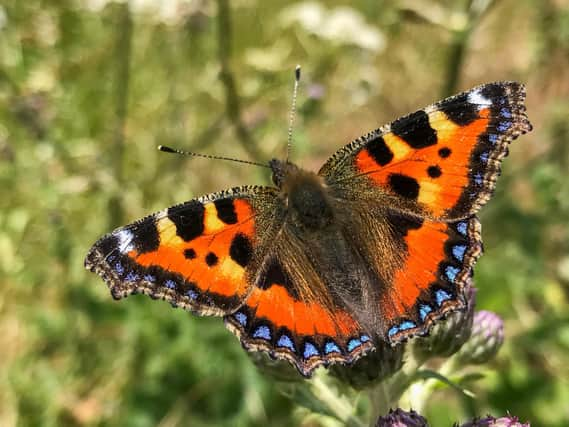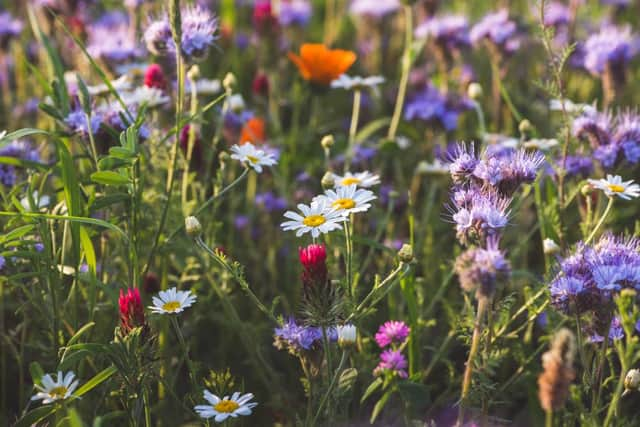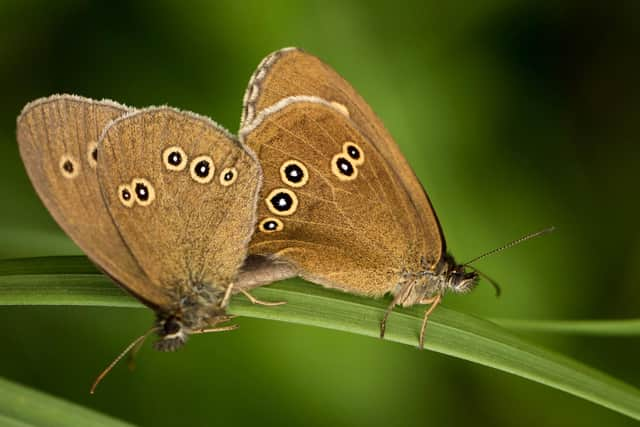How to support pollinators like butterflies and bees in your garden during No Mow May
This article contains affiliate links. We may earn a small commission on items purchased through this article, but that does not affect our editorial judgement.


Five species of butterfly have become extinct in the last 150 years. And a 2021 report from Butterfly Conservation Europe found that, in the United Kingdom, nearly one in ten (8%) of resident species have become extinct, and since 1976, overall numbers declined by around 50%.
UK butterfly numbers are fluctuating according to the annual data. Despite good growth reported in recent years, almost half of UK butterfly species still had below-average population levels last year. According to the charity Butterfly Conservation, destruction of habitats resulting from land-use change is the key cause of this decline.
Advertisement
Hide AdAdvertisement
Hide AdWith this month being No Mow May, a time to encourage the UK to let lawns grow and encourage flower diversity, now’s the perfect time to re-wild your garden with native wildflowers to support butterflies and bees.


Elizabeth Waddington, permaculture designer and environmental writer at Horticulture.co.uk, says: “Changing climate and weather patterns, habitat loss and environmental pollutants threaten these beautiful creatures. Our gardens are a place where we can stem the tide, and help tackle the biodiversity crisis.”
Encouragingly, there’s been a surge in consumers buying wildflowers throughout the UK. These offer alternative habitats and food for caterpillars, butterflies and other pollinators. Wildlife supplies website Ark Wildlife reports a 846% increase in demand for wildflower products from 2020 to 2021, meaning support for butterflies and bees is starting to gain momentum.
Sean McMenemy, wildlife expert and director at Ark Wildlife, has spoken to gardening experts and provided his own expertise on how to make a garden butterfly-friendly with wildflowers.
Advertisement
Hide AdAdvertisement
Hide AdHow to support wildlife this No Mow May, and make your garden into a butterfly-friendly wildflower meadow


The more wildflowers that are flourishing, the better our butterfly populations will fare. Of course, our gardens aren’t at quite the same scale as a farmer’s meadow.
By taking simple steps to transform your own garden though, you can support the rise of pollinator species numbers whilst boosting your own wellbeing by engaging with nature. Here are Sean’s tips for doing so:
- Collect your native wildflower seed mixes. While not definitively better, native wildflowers are generally preferred by beneficial insects such as butterflies and bumblebees because they have evolved to use these plants as food for caterpillars and also as nectar and pollen for the adults.
- Choose a patch in your garden, as small or large as you have space for. Preferably, a spot that gets a lot of sun.
Advertisement
Hide AdAdvertisement
Hide Ad- Planting native wildflowers couldn’t be easier. They’re tough and easy to grow – just scatter seeds on any bare earth and leave them to it.
- Of course, you can improve germination rates by taking time to prepare seed beds in borders, or by scattering specially prepared ‘seedballs’ rather than bare seeds.
- Watch your meadow grow and flower in the spring and summer, and enjoy helping the butterflies prosper.
As rain is finally forecast following a dry spring, now is the perfect time to broadcast wildflower seeds to naturalise in borders and hedgerows. You can make the most of No Mow May by creating your own colourful, wildflower-rich lawn.
Advertisement
Hide AdAdvertisement
Hide AdWhat else can be done to support butterflies in the garden?
Elizabeth Waddington says: “Our gardens are extremely important ecosystems – oases of green in our towns and cities. As gardeners, we should do all we can to use our gardens wisely. We should do what we can to attract and protect all the other creatures with whom we share our space. Butterflies and other invertebrates are particularly important.
“Native butterflies have formed symbiotic relationships with certain native plants and so when we plant native species, or allow wild plants to flourish in wilder corners of our gardens, we help specific butterfly and moth species in very specific ways. We help to maintain these crucial ecosystem links which are being lost from other areas of our landscapes. Some plants provide sites for butterflies to lay their eggs, and food for larvae and caterpillars. Others provide nectar for the adults. And some may also provide shelter for overwintering species.”
As well as planting native wildflower species, there is the option to integrate exotic plants into your garden meadow too.
Sean McMenemy says: “If you do choose exotic plant species, look for big open flowers with strong scent, as these tend to have more nectar and the pollen is more accessible in open flowers.
Advertisement
Hide AdAdvertisement
Hide Ad“Many beneficial insects such as butterflies can be attracted to gardens and helped in many ways. Lots of fragrant flowers are a given but they also need water, so put out a shallow-sided dish of water in the garden and make sure it doesn’t have slippery edges. A terracotta plant saucer is ideal.
“Another tip is to watch out for cold spells, as many flowers will close to protect themselves, but this prevents butterflies from feeding. During such times (or whenever natural food is scarce), make a mix of sugar water and soak it in a sponge or cloth and put it out in a shady spot. Butterflies and bumblebees will sniff it out for a quick ‘pit stop’ when needed.”
Which charities and causes can you support for UK butterfly conservation?
- Support No Mow May efforts with https://www.plantlife.org.uk/uk
A message from the editor:
Thank you for reading. NationalWorld is a new national news brand, produced by a team of journalists, editors, video producers and designers who live and work across the UK. Find out more about who’s who in the team, and our editorial values. We want to start a community among our readers, so please follow us on Facebook, Twitter and Instagram, and keep the conversation going.